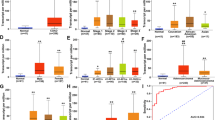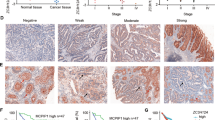Abstract
CXCL13, an inflammatory factor in the microenvironment, plays a vital role in the progression of inflammatory diseases and tumors. CXCL13 and its receptor CXCR5 have been reported to be associated with poor prognosis of advanced colon cancer. However, the molecular mechanisms of CXCL13-CXCR5 axis in colon cancer remain elusive. The aim of this study was to investigate the role of CXCR5-CXCL13 axis in the growth and invasion of colon cancer cells. Our results showed that CXCL13 promoted the growth, migration, and matrigel invasion of colon cancer cells. Furthermore, CXCL13 increased the expression and secretion of MMP-13, and stimulated the activation of PI3K/AKT pathway. After knockdown of CXCR5 by siRNA, the biological functions of colon cancer cells regulated by CXCL13 were significantly inhibited. In addition, inhibition of PI3K/AKT pathway by specific inhibitor LY294002 suppressed the CXCL13-mediated growth, migration, and invasion of colon cancer cells. Together, our findings suggest that CXCL13-CXCR5 axis promotes the growth, migration, and invasion of colon cancer cells, probably via PI3K/AKT pathway. Thus, CXCL13 may be a useful biomarker for the detection and treatment of colon cancer.






Similar content being viewed by others
References
Siegel R, Desantis C, Jemal A (2014) Colorectal cancer statistics, 2014. CA Cancer J Clin 64(2):104–117. doi:10.3322/caac.21220
Segal NH, Saltz LB (2009) Evolving treatment of advanced colon cancer. Annu Rev Med 60:207–219. doi:10.1146/annurev.med.60.041807.132435
Terzic J, Grivennikov S, Karin E, Karin M (2010) Inflammation and colon cancer. Gastroenterology 138(6):2101–14e5. doi:10.1053/j.gastro.2010.01.058
Gunn MD, Ngo VN, Ansel KM, Ekland EH, Cyster JG, Williams LT (1998) A B-cell-homing chemokine made in lymphoid follicles activates Burkitt’s lymphoma receptor-1. Nature 391(6669):799–803. doi:10.1038/35876
Pevzner V, Wolf I, Burgstahler R, Forster R, Lipp M (1999) Regulation of expression of chemokine receptor BLR1/CXCR5 during B cell maturation. Curr Top Microbiol Immunol 246:79–84; discussion 5
Baay-Guzman GJ, Huerta-Yepez S, Vega MI, Aguilar-Leon D, Campillos M, Blake J et al (2012) Role of CXCL13 in asthma: novel therapeutic target. Chest 141(4):886–894. doi:10.1378/chest.11-0633
Rupprecht TA, Plate A, Adam M, Wick M, Kastenbauer S, Schmidt C et al (2009) The chemokine CXCL13 is a key regulator of B cell recruitment to the cerebrospinal fluid in acute Lyme neuroborreliosis. J Neuroinflamm 6:42. doi:10.1186/1742-2094-6-42
Hussain SK, Zhu W, Chang SC, Breen EC, Vendrame E, Magpantay L et al (2013) Serum levels of the chemokine CXCL13, genetic variation in CXCL13 and its receptor CXCR5, and HIV-associated non-hodgkin B-cell lymphoma risk. Cancer Epidemiol Biomark Prevent 22(2):295–307. doi:10.1158/1055-9965
Rubenstein JL, Wong VS, Kadoch C, Gao HX, Barajas R, Chen L et al (2013) CXCL13 plus interleukin 10 is highly specific for the diagnosis of CNS lymphoma. Blood 121(23):4740–4748. doi:10.1182/blood-2013-01-476333
Panse J, Friedrichs K, Marx A, Hildebrandt Y, Luetkens T, Barrels K et al (2008) Chemokine CXCL13 is overexpressed in the tumour tissue and in the peripheral blood of breast cancer patients. Br J Cancer 99(6):930–938. doi:10.1038/sj.bjc.6604621
Razis E, Kalogeras KT, Kotoula V, Eleftheraki AG, Nikitas N, Kronenwett R et al (2012) Improved outcome of high-risk early HER2 positive breast cancer with high CXCL13-CXCR5 messenger RNA expression. Clin Breast Cancer 12(3):183–193. doi:10.1016/j.clbc.2012.03.006
Qi XW, Xia SH, Yin Y, Jin LF, Pu Y, Hua D et al (2014) Expression features of CXCR5 and its ligand, CXCL13 associated with poor prognosis of advanced colorectal cancer. Eur Rev Med Pharmacol Sci 18(13):1916–1924
Zucker S, Vacirca J (2004) Role of matrix metalloproteinases (MMPs) in colorectal cancer. Cancer Metastasis Rev 23(1–2):101–117
Liebmann C (2004) G protein-coupled receptors and their signaling pathways: classical therapeutical targets susceptible to novel therapeutic concepts. Curr Pharm Des 10(16):1937–1958
Fischer L, Korfel A, Pfeiffer S, Kiewe P, Volk HD, Cakiroglu H et al (2009) CXCL13 and CXCL12 in central nervous system lymphoma patients. Clin Cancer Res 15(19):5968–5973. doi:10.1158/1078-0432
Singh S, Singh R, Sharma PK, Singh UP, Rai SN, Chung LW et al (2009) Serum CXCL13 positively correlates with prostatic disease, prostate-specific antigen and mediates prostate cancer cell invasion, integrin clustering and cell adhesion. Cancer Lett 283(1):29–35. doi:10.1016/j.canlet.2009.03.022
Singh S, Singh R, Singh UP, Rai SN, Novakovic KR, Chung LW et al (2009) Clinical and biological significance of CXCR5 expressed by prostate cancer specimens and cell lines. Int J Cancer 125(10):2288–2295. doi:10.1002/ijc.24574
El-Haibi CP, Singh R, Sharma PK, Singh S, Lillard JW Jr (2011) CXCL13 mediates prostate cancer cell proliferation through JNK signalling and invasion through ERK activation. Cell Prolif 44(4):311–319. doi:10.1111/j.1365-2184.2011.00757.x
Meijer J, Zeelenberg IS, Sipos B, Roos E (2006) The CXCR5 chemokine receptor is expressed by carcinoma cells and promotes growth of colon carcinoma in the liver. Cancer Res 66(19):9576–9582. doi:10.1158/0008-5472.CAN-06-1507
Biswas S, Sengupta S, Roy Chowdhury S, Jana S, Mandal G, Mandal PK et al. (2014) CXCL13-CXCR5 co-expression regulates epithelial to mesenchymal transition of breast cancer cells during lymph node metastasis. Breast Cancer Res Treat 143(2):265–276. doi:10.1007/s10549-013-2811-8
El-Haibi CP, Singh R, Gupta P, Sharma PK, Greenleaf KN, Singh S et al (2012) Antibody microarray analysis of signaling networks regulated by Cxcl13 and Cxcr5 in prostate cancer. J Proteom Bioinform 5(8):177–184. doi:10.4172/jpb.1000232
Brown PD (1997) Matrix metalloproteinase inhibitors in the treatment of cancer. Med Oncol 14(1):1–10
Pandruvada SN, Yuvaraj S, Liu X, Sundaram K, Shanmugarajan S, Ries WL et al (2010) Role of CXC chemokine ligand 13 in oral squamous cell carcinoma associated osteolysis in athymic mice. Int J Cancer 126(10):2319–2329. doi:10.1002/ijc.24920
Kanbe K, Shimizu N, Soda Y, Takagishi K, Hoshino H (1999) A CXC chemokine receptor, CXCR5/BLR1, is a novel and specific coreceptor for human immunodeficiency virus type 2. Virology 265(2):264–273. doi:10.1006/viro.1999.0036
Sambandam Y, Sundaram K, Liu A, Kirkwood KL, Ries WL, Reddy SV (2013) CXCL13 activation of c-Myc induces RANK ligand expression in stromal/preosteoblast cells in the oral squamous cell carcinoma tumor-bone microenvironment. Oncogene 32(1):97–105. doi:10.1038/onc.2012.24
El Haibi CP, Sharma PK, Singh R, Johnson PR, Suttles J, Singh S et al (2010) PI3Kp110-, Src-, FAK-dependent and DOCK2-independent migration and invasion of CXCL13-stimulated prostate cancer cells. Mol Cancer 9:85. doi:10.1186/1476-4598-9-85
Agarwal E, Brattain MG, Chowdhury S (2013) Cell survival and metastasis regulation by Akt signaling in colorectal cancer. Cell Signal 25(8):1711–1719. doi:10.1016/j.cellsig.2013.03.025
Conflict of interest
All authors declare no conflict of interests.
Author information
Authors and Affiliations
Corresponding author
Additional information
Zhenyu Zhu and Xukui Zhang have contributed equally to this study, and both should be considered as first author.
Rights and permissions
About this article
Cite this article
Zhu, Z., Zhang, X., Guo, H. et al. CXCL13-CXCR5 axis promotes the growth and invasion of colon cancer cells via PI3K/AKT pathway. Mol Cell Biochem 400, 287–295 (2015). https://doi.org/10.1007/s11010-014-2285-y
Received:
Accepted:
Published:
Issue Date:
DOI: https://doi.org/10.1007/s11010-014-2285-y




